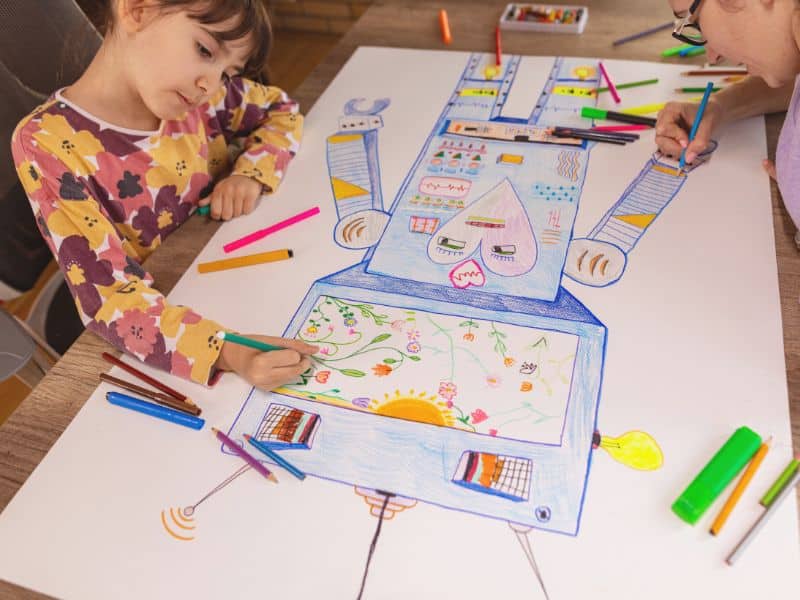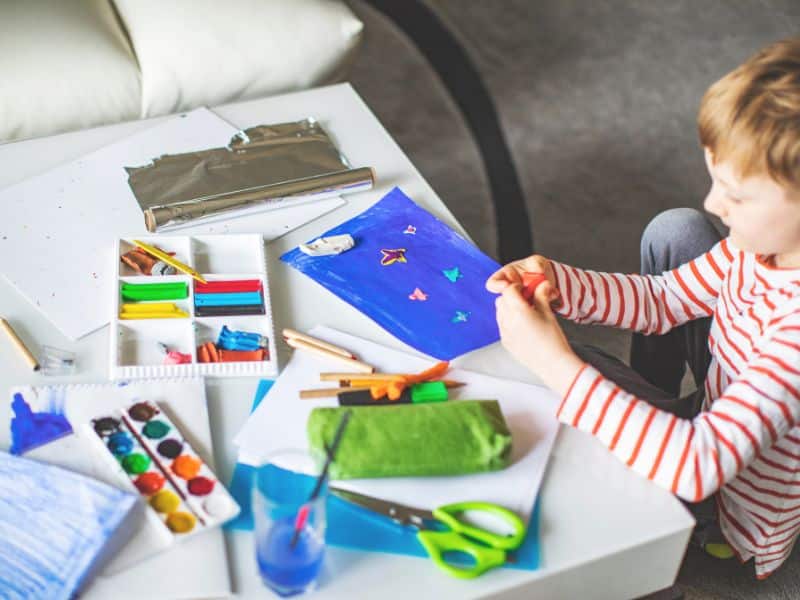HOW TO DEVELOP CREATIVITY SKILLS | ENCOURAGE OUTSIDE THE BOX THINKING
If you have ever wondered how to develop creativity skills in children or is it even possible to develop a skill like creativity, the answers are right here in this article.
Turns out, creativity skills are not something that are inherited to us at birth. Unlike IQ or language skills that can be inherent, Creativity develops in us from very young age. All it takes is a fertile environments where there’s plenty of opportunities for thinking independently and creatively.
Activities to develop creativity skills are vital in Early childhood Education as the first five years bring a booming growth in many skills in children.

So how do we help them be creative thinkers? It is a good questions that parents have asked themselves because creative thinking is an essential skills in 21st century. The world is changing rapidly so the ones who do think differently and more proficiently will definitely have the upper hand in life in general.
But some have the misconception that creativity is only about Art. But it is also about how a child thinks and solves problems, comes up with ideas, explores and creates opportunities. Creativity is associated with focus, independence, a willingness to explore and ingenuity.
Let’s see the benefits of thinking outside the box. Do they really deserve the hype it has had over the years? Let’s see what creative skills can bring into your child’s life.
Benefits of Creativity Skills
Develop Imagination
Thinking creatively and independently can develop children’s imagination. It opens up a whole new world where everything is possible with no restrictions or limitations.
A child may draw a pink elephant and explain how the elephant got pink. May be it has fallen into a pink paint river or has had a pink salt bath. When it comes to imagination, sky is the limit. Let them imagine everything ordinary to extraordinary, probable to improbable, real to magic.
Build Confidence
Being able to explore an idea and coming up with a solution fills them up with confidence. Because it’s their own thinking process and their own problem solving.

Understand and Express Emotions
Creativity can be a great way to express one’s emotions. Let them use paint, crayons, recycled objects. Let them find natural objects found in nature like twigs, leaves, pinecones to build up something with their emotions and feelings put into it.
It’s easier to express emotions and feelings through creativity than through words.
learn about the world and their place in it.
Practise and Improve Social Skills
Creativity can be a good way of connecting with others. The process of it like building , creating, painting, practising and presenting the final product can also give lots of opportunities for kids to improve how they interact with peers and adults.
Improve fine motor skills, gross motor skills and hand-eye coordination- Creativity may involve using objects like twigs, paint brushes, leaves, rocks or movements like dancing, climbing or throwing. All these improve their gross motor skills, fine motor skills and hand eye coordination.
Ex: Building a mud castle involves hand-eye coordination.
Build Vocabulary and Memory
True, children get to be creative mostly during unstructured play. Though it’s unstructured with minimum adult involvement, this kind of play requires children to do a lot of communication and thinking all by themselves. It builds up their vocabulary and memory.
Practise Decision-Making, Problem-Solving and Critical Thinking
With minimum adult intervention, children will be doing things all by themselves, learning through trial and error, finding better and easier ways to do things with what they have. It requires a lot of decision making, problem solving and critical thinking skills.
How to Develop Creativity Skills in Children?

As we’ve discussed before, creativity grows in fertile environment full of freedom to make choices, play and express oneself. Creativity is children’s unique response to all that they see, hear, feel and experience. A child’s individual responses to materials, experiences and ideas inspire their creativity and imagination.
It’s not something we are born with. So the good news is all our children can learn and excel in that skills.
Though minimum adult participation is required here, making a suitable environment for our children to grow, be creative, be independent thinkers is totally up to us.
Let’s see how we can do that.
Find creative outlets for children to express themselves
Drawing, painting, or sculpting are just a few of the many outlets available for kids to explore.
Arts and crafts can help children learn valuable decision-making skills as they choose which direction their projects will take.
Parents or teachers who facilitate these activities can also help foster a positive atmosphere for creativity, allowing children to feel safe taking risks and exploring new ideas.
Encouraging our young people to find creative outlets is essential in helping make decision making for kids an enjoyable experience.
Encourage students to think outside the box and come up with innovative ideas
With decision making for kids, students can explore new ways of thinking that help them formulate creative solutions to solve their everyday problems.
Encouraging students to think outside the box not only allows them to practise problem-solving skills, but also provides them with countless opportunities to come up with innovative ideas and develop new approaches towards issues.
By having access to resources such as decision making for kids, students will be able to better express their independent thought and closely examine any given situation from a different perspective. This may not only increase problem-solving capabilities for individuals, but it could also positively impact society in the future.
Give them access to resources and materials that can help develop their creativity
It's never too early to teach kids to make good decisions and foster creativity.
Giving them access to the right resources and materials can have a positive impact on their creative thinking and problem-solving abilities.
For example, Decision Making for Kids offers a library of interactive activities that guide children through the decision-making process.
From brainstorming ideas to learning how to weigh pros and cons, Decision Making for Kids helps kids explore their creative side while honing problem-solving skills. The variety of games, quizzes, and stories available provide ample opportunities for kids to express themselves creatively as they learn valuable life lessons.
Allow time each day for children to explore and engage with their imaginations without any pressure or expectations
Allowing children to have time each day to explore and engage with their imaginations offers a special opportunity to exercise creativity and independent decision making.
Such time free of pressure or expectations enables kids to find the joy in thinking freely, and create without fear of judgement. Spend an hour this week giving your child the space for creative thought and discovery, so they can build confidence in the decisions they make and take ownership of their goals.
This not only encourages confidence-building but also establishes the idea that we all have an interesting story to tell - an invaluable lesson to learn during childhood.
Allow students to take risks and make mistakes in order to foster a creative environment
Allowing students to take risks and make mistakes within a supportive environment is an important way to fuel their creativity and independence.
By making the space for kids to take calculated risks and make decisions, we give them the confidence, experience and skills needed for success in life later on.
We must help bridge that gap between safety and comfort in their lives, with exploration of new ideas and cultivating a growth mindset which considers failure as opportunities for learning - all aspects of decision making for kids.
With this freedom comes responsibility, where our role often shifts from providing comprehension but guiding gently from behind the scenes.
Mistakes create a valuable opportunity provide guidance, encouragement, fostering future resilience by engaging in interactive activities that allow kids to practice such decision making habits outside of the classroom.
Keep a ‘busy box’ of new and recycled play materials
Materials like yarn, pompoms, cardboard boxes , beads, crayon, paint, glue, wooden hoops, tape can be used to create so many beautiful crafts.
Your child can use these materials to make whatever they want.
Give your child an empty cardboard box to decorate. They might make a house, a robot, a truck, – whatever they’re interested in.
Use old milk bottles, cups, formula tins, spoons for them to make bird feeders, plant seeds etc.
Start a dress-up box or bag
Use old clothes or find cheap and unusual clothes and props at op-shops.
Put on a puppet show or do other kinds of puppet play. You could even use a cardboard box to create a puppet theatre.
Pitch a tent in your backyard and pretend to go on a camping adventure.
Act out things from daily life. It could be going to the doctor, market or post office.
At story time, use different voices and act out the story with your child. Give them roles and let them add up their own words to that character. Make it your child's own version of the story and let them showcase their creativity skills.
Outdoor nature play
Nature can provide wonderful inspiration for children’s creative explorations. Let them engage all their five senses in natural surrounding.
Listen to the chattering of the creek, smell sweet-smelling flowers, gaze at the patterns created by moving clouds, taste rain water and help children embrace the amazing beauties found in nature.
They can collect pebbles and make patterns, make flower garlands, bird feeders. Bigger kids can make waterways from the creek towards nearby vegetable patches, build up bridges for small waterways for animals to crossover, make natural habitats and so many fun yet environmental friendly activities which will stimulate their thinking process and innovative skills.
Malleable materials
Malleable materials are simply materials that children can shape themselves, perhaps by pulling, stretching, pushing, rolling, squeezing, poking or pinching. Children can use playdough, clay , bread dough, kinetic sand etc for this.
These materials provide endless ways to be creative using objects like bottle lids, twigs, sticks, sea shells, rocks etc. You can provide cookie cutters or playdough cutters to help them shape and create artistic pieces.
Tips to Develop Creativity Skills

- It can get messy and it’s ok
- Encourage experimentation
- Appreciate your child’s creative products without trying to make changes.
- Emphasize the process of creativity , not just the final product.
- Give the children independence and the control they need to create.
- Share children’s excitement for discovery, exploration and
- Remember that supporting children’s development is always a balancing act: how much structure, how much freedom; when to step in, when to step back; when to show, when to tell, when to ask, when to listen – Resources : https://www.virtuallabschool.org/preschool/creative-expression/lesson-2
Conclusion
Creativity skills supports mental growth through challenges involving elements like equality, balance, spatial relationships, and problem-solving.
It also supports the development of key skills such as sensory perception, verbal skills, and hand-eye coordination. Additionally, it supports divergent thinking via activities involving reflection, wonder, and curiosity.
Creativity also provides children with opportunities for experimentation, imagination, and freedom of expression. Finally, creativity shapes social skills through activities that involve different perspectives and values and understanding the needs of others.
Let us know your tips to develop creativity skills in your children.

Leave a Reply